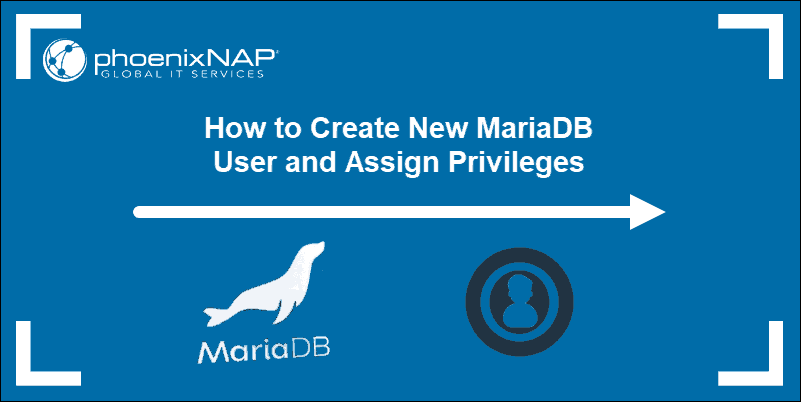The LEMP stack is a popular open-source setup used to build and deploy high-performance, dynamic web applications. It combines several technologies that manage web server requests, process content that changes based on user input or data, and handle database interactions in real time.
This tutorial will explain what LEMP is and how it works. It will also elaborate on its components, benefits, and challenges.
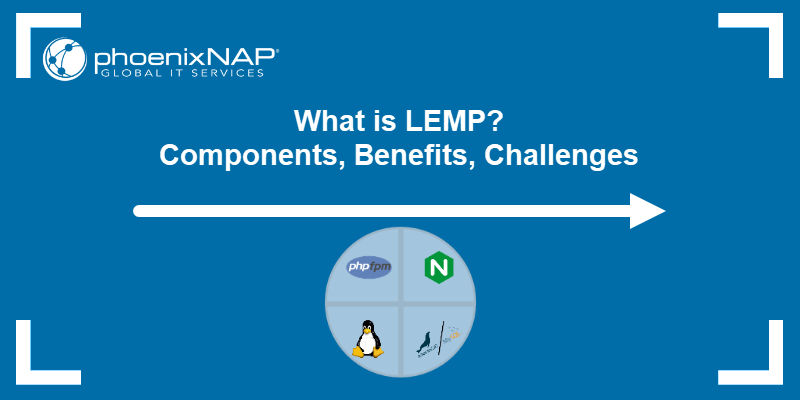
What Is LEMP?
LEMP is a widely used technology stack designed to serve and manage dynamic web applications. It processes user requests, executes application logic, and manages stored data efficiently.
The stack consists of four key components, each playing a specific role in delivering dynamic web content. The acronym LEMP is derived from the first letters of these components:
- L for the Linux operating system.
- E for Nginx, a fast web server that handles incoming HTTP requests.
- M for MariaDB or MySQL, the relational database management systems that store and manage the data behind dynamic websites. MariaDB is often used as a replacement for MySQL due to its improved performance and security features.
- P for PHP, a server-side scripting language that generates web content and interacts with the database. LEMP uses PHP-FPM (FastCGI Process Manager), which allows Nginx to keep worker processes running instead of spawning new ones for each request.
LEMP is a LAMP stack variant that replaces Apache with Nginx. This combination of open-source technologies makes LEMP a flexible, scalable, and widely adopted solution for web development.
LEMP Stack Components
The LEMP stack is built on a modular architecture, where components work together to deliver web applications efficiently. Nginx serves as the web server, PHP processes dynamic content, and MySQL or MariaDB handles database operations on a Linux-based system.
Understanding how these parts interact is key to optimizing performance and scalability.
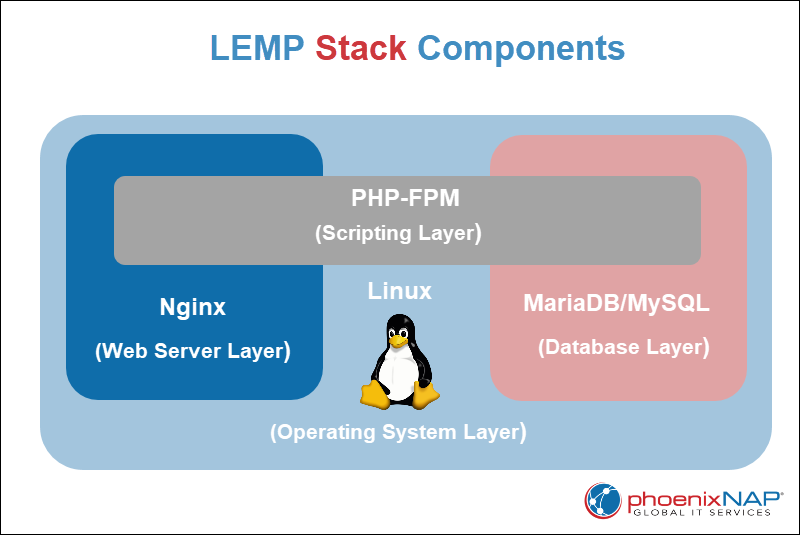
Linux
Linux is an open-source operating system known for its stability, security, and flexibility. It is the basis for many modern containerized environments, like Docker, that are commonly used to deploy LEMP-based applications.
As the LEMP stack foundation, it provides a reliable environment for web applications because it manages system resources, handles communication between software and hardware, and supports Nginx, MariaDB or MySQL, and PHP.
Its open-source nature gives developers full control over configurations, enabling them to fine-tune settings, install the necessary software, and optimize performance to meet application needs.
Linux works across various hardware and software, making it a flexible choice for scalable web applications. Its strong security features help protect hosted applications from vulnerabilities.
Nginx
Nginx (pronounced Engine-X) is an efficient and fast open-source web server. It handles HTTP requests, serves static files, and forwards dynamic requests to PHP-FPM for processing.
Unlike Apache, which creates a new process for each connection, Nginx uses an event-driven model to manage thousands of simultaneous connections with minimal resource usage. This makes it ideal for high-traffic websites and performance-critical applications.
As part of the LEMP stack, Nginx replaces Apache (used in the LAMP stack) to improve scalability and responsiveness. However, Apache still offers more flexibility with features like .htaccess for per-directory configurations.
Nginx handles multiple users simultaneously, directs requests to the appropriate backend services, and acts as a load balancer when needed.
These capabilities make Nginx a key component in LEMP, ideal for web applications that require high performance and reliability.
MySQL and MariaDB
MySQL and MariaDB are relational database management systems used in the LEMP stack to store and manage the data for dynamic websites. They use Structured Query Language (SQL) to organize and query data, making them great for applications that require structured storage and retrieval.
MySQL supports vertical scalability, which means databases expand by adding more resources (like CPU and RAM) to a single server. MySQL also allows horizontal scalability through replication and partitioning, which distribute data across multiple servers. This process makes it suitable for large datasets and high-traffic websites. However, high workloads need additional optimization to ensure performance.
MariaDB, a fork of MySQL, is chosen over MySQL in the LEMP stack due to its improved performance, security features, and active development. MariaDB offers additional features such as better default storage engines and enhanced query optimization. It also focuses more on community-driven development, which provides more transparency and flexibility for developers.
Both MariaDB and MySQL are suitable for the LEMP stack as they provide reliable, scalable solutions for data management. However, MariaDB is often preferred due to its increased speed, better security, and stronger community-driven development.
PHP
PHP (Hypertext Preprocessor) is a server-side scripting language that generates dynamic web content and manages database interactions in the LEMP stack. When a user requests a page, the server executes PHP scripts to create the content instantly.
In the LEMP stack, PHP scripts are processed by PHP-FPM (FastCGI Process Manager), which manages persistent worker processes for improved performance. PHP-FPM is designed for use with Nginx to efficiently handle PHP requests by communicating with Nginx via FastCGI, eliminating the overhead of starting new PHP processes for each request.
PHP embeds directly into HTML, allowing developers to insert dynamic content into static pages. It also integrates with MariaDB or MySQL for database interactions.
Unlike the LAMP stack, where the P could refer to PHP, Perl, or Python, in the LEMP stack, P specifically stands for PHP. This is because Nginx doesn't have built-in support for Perl or Python scripts like Apache does.
PHP is preferred in the LEMP stack due to its extensive support for web development, efficient handling of dynamic content generation, and broad community support.
How Does LEMP Stack Work?
Understanding how the LEMP stack processes requests helps developers optimize performance, troubleshoot issues, and build scalable applications. Each component is crucial in handling user interactions, generating dynamic content, and managing data efficiently.
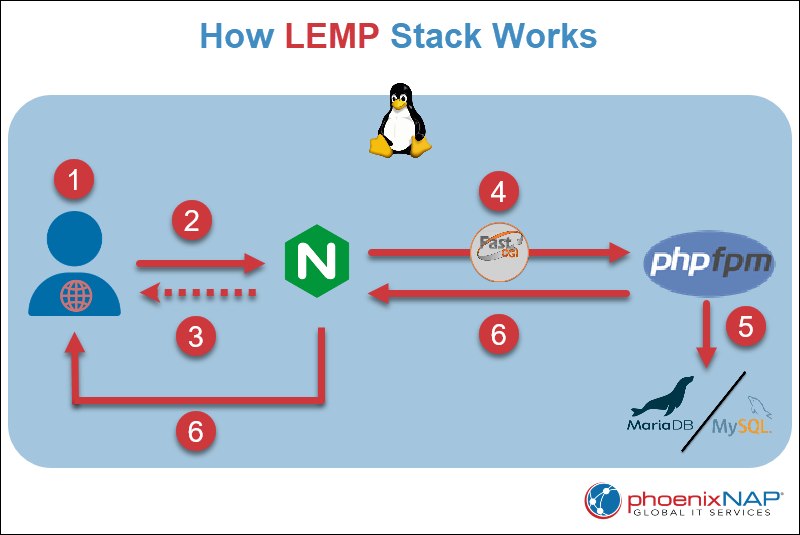
The following text explains how these components process user requests:
1. A user enters a URL in their browser and sends an HTTP request to the server.
2. Nginx, running on a Linux-based server, receives the request and determines whether it needs static or dynamic content.
3. Nginx serves static content (such as images, CSS, or JavaScript files) directly to the browser.
4. For dynamic content, Nginx forwards it to PHP-FPM via FastCGI. This protocol enables efficient communication between the web server and PHP. It keeps the PHP process running persistently instead of restarting it for each request.
5. PHP-FPM executes the necessary scripts. If database access is required, it retrieves or updates data in MariaDB or MySQL.
6. PHP-FPM generates the final output, usually an HTML response, and sends it back to Nginx.
7. Nginx delivers the final HTML content to the user's browser, where it is rendered and displayed.
These steps process the user's request from the initial URL entry to the final webpage display. The result is a fully rendered webpage, with dynamic content from PHP and data from MariaDB/MySQL, delivered as an HTML response for the browser to display.
LEMP Benefits
Knowing the benefits of the LEMP stack helps developers choose the right technology for web applications. Understanding these advantages ensures better decision-making when building and optimizing websites.
The following list presents the most important LEMP benefits:
- High performance. Nginx's design allows it to handle many connections simultaneously while using a few resources. It outperforms traditional process-based servers, reduces latency, and improves response times.
- Scalability and flexibility. The LEMP stack supports both vertical and horizontal scaling, which allows applications to expand easily. Nginx's ability to distribute traffic ensures stable performance as the load increases.
- Cost-effectiveness. Every component is open source, meaning developers can use, modify, and optimize the stack without licensing fees.
- Security and reliability. Nginx provides built-in security features such as rate limiting, SSL/TLS encryption, and protection against cyber attacks.
- Efficiency in handling dynamic content. PHP efficiently processes server-side logic and generates dynamic content while working seamlessly with MariaDB or MySQL. FastCGI improves performance by keeping PHP processes running. While not part of the core LEMP stack, modern LEMP setups often integrate caching solutions like Redis or Varnish. These tools enhance performance by reducing database load and speeding up content delivery, making them ideal for high-traffic applications.
- Large community and support. Each LEMP component has an active community, extensive documentation, and widespread adoption. Developers have access to forums, tutorials, and third-party tools to troubleshoot issues and optimize performance.
LEMP Challenges and Limitations
Understanding the LEMP stack disadvantages and challenges helps developers make informed decisions when building web applications.
Recognizing potential limitations prevents future issues, optimizes performance, and ensures the stack meets specific project requirements.
Refer to the list below for some common LEMP challenges:
- Configuration limitations. Nginx is less flexible than Apache when it comes to additional configurations. While it offers high performance, it doesn't support as many custom configurations or dynamic modules as Apache.
- Platform dependency. Although LEMP components are cross-platform, they are traditionally associated with Linux. This is a limitation for projects that require native compatibility across multiple OSes.
- Relational database limitations. MariaDB/MySQL works well with structured data but struggles with unstructured data compared to non-relational databases. This limits applications that require highly flexible data handling.
- Performance under heavy load. Nginx is generally efficient, but under extremely high traffic, it sometimes requires additional configurations to maintain performance. Unlike other more scalable solutions, it has to be optimized for specific workloads.
- Complexity in dynamic content handling. Nginx requires separate modules and processes to handle dynamic content generation, which complicates the setup compared to more integrated solutions like Apache.
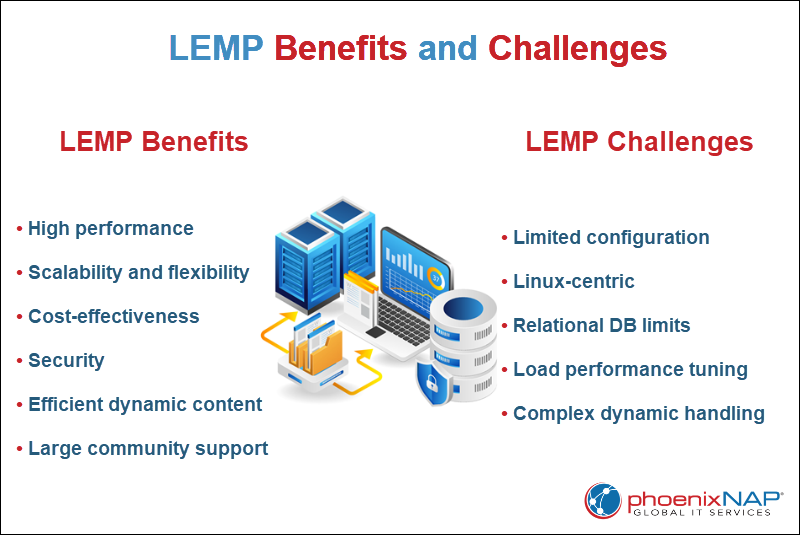
Conclusion
This tutorial explained what the LEMP stack is and its components. It also elaborated on how those components work together. The text included elaborate lists of LEMP benefits and challenges.
Apart from LEMP, learn about the two other popular open-source web stack solutions, LAMP and MEAN, and how they compare.


